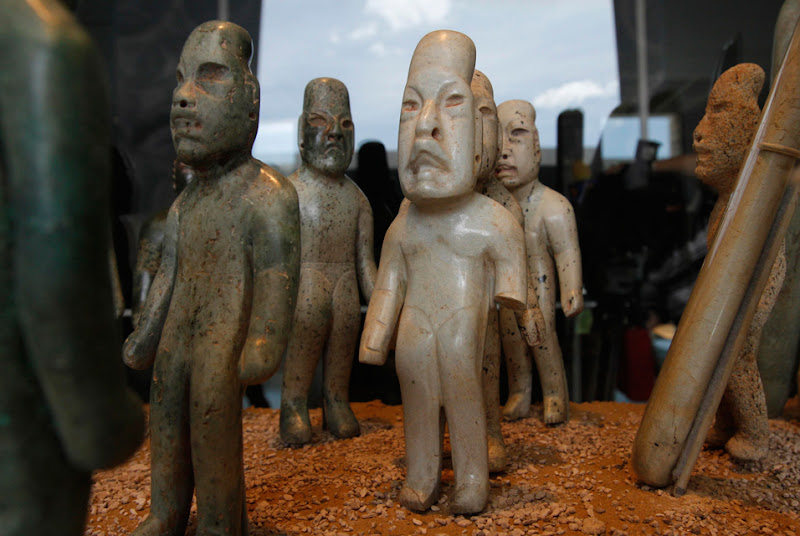After the success at the Los Angeles County Museum of Art and de Young Museum in San Francisco, in the United States, where nearly 600,000 persons visited it, the exhibition Colossal Masterworks from Olmeca World is now open at the National Museum of Anthropology (MNA), where visitors may admire two original colossal heads that weigh more than 4 tons each.

During a visit with communication media representatives, Miriam Kaiser, INAH Director of Exhibitions, explained that the show is comprised by 116 works, among them the Colossal Heads known as 5 and 9, of 4 and 6 tons of weight respectively, found in San Lorenzo, Veracruz, and part of the Xalapa Museum of Anthropology (MAX) collection.
“None of the 17 colossal heads found until now in the Gulf of Mexico Region is similar to another, they all have different features, and, generally, is how rulers were depicted. But nothing written has been found to allow us to know the name of these rulers. The Olmeca culture still keeps its secrets”, declared Miriam Kaiser.
Archaeologist Erika Gomez, exhibition project coordinator at INAH, commented that the show is divided in 4 parts: The first one is about the splendor of the Olmecas (1800-400 BC); the second part is related to sculptures that represent hierarchy and power; the third one refers to regions influenced by the Olmecas and the last one, to the legacy of this culture.
Among the great format pieces are a group of sculptures called Azuzules, referring the place where they were found in the Mexican state of Veracruz. Four sculptures, among them a jaguar and 2 characters, maybe warriors or priests, named Gemelos I y II (Twins 1 and 2) because they are identical, are exhibited at the National Museum of Anthropology.
As the main part of the exhibition is comprised of monumental sculptures, it was mounted at the lobby of Gulf Coast, Oaxaca and Mexica Halls, with all security measures taken.
Obras Colosales del mundo Olmeca includes ceramic and jade objects as well as a 3,200 year-old wooden bust from El Manati Archaeological Site, mounted with humidity and temperature monitoring devices.
Among them is a pair of jadeite votive axes dated between 900 and 400 BC found in La Venta, Tabasco. One of them represents a corncob and the other a human face between 2 small cobs.
Offering 4 from La Venta, Tabasco dated in the same period, is on display. Consisting of jadeite, serpentine and granite objects, represents a ceremonial scene, with 6 jadeite axes forming a wall with a person at the center. Other 15 persons, 2 of them made of jadeite and the rest, representing bold men, made of serpentine, are also part of the offering.
The Contortionist also outstands. The Las Choapas, Veracruz piece dated between 1200 and 600 BC, represents an acrobat with his feet on his head. The pose, observed in monumental and small sculptures as well, is a symbolic representation for both Mayas and Olmecas, of a ruler personified as the maize deity.
Monument 34, from Texistepec, Veracruz, dated between 1400 and 1000 BC, is another monumental piece at the National Museum of Anthropology; it is almost one meter high and was deposited as an offering during the Prehispanic age.
Other outstanding works are the sculpture The Dancing Jaguar, one meter high, dated between 600 and 300 BC and found in Tuxtla Chico, Chiapas; and Monument 19, from Acayucan, Laguna de los Cerros, Veracruz (1200-1000 BC), which represents a standing beheaded person, maybe made during a change of power.
Olmeca culture greatness can be admired by the Mexican public at the exhibition Colossal Masterworks of Olmeca World which conquered the American public for almost 8 months during the exhibit in San Francisco and Los Angeles.
Curated by the recently departed Virginia Mary Fields, who was a specialist in Ancient American Art at LACMA, this great exhibition is composed by pieces from museums that are part of the INAH network as well as independent museums such as Xalapa Anthropology Museum and Museo Amparo of Puebla.
Obras Colosales del mundo Olmeca at the National Museum of Anthropology (MNA) will be open until late October 2011. The entrance fee is 51 MXP but students and teachers with a valid ID, children under 13, senior citizens over 60 do not pay. On Sunday entrance is free for Mexican residents presenting their ID. The museum is open Tuesday to Sunday from 9:00 to 19:00 hours.
Source: Art Daily [July 23, 2011]
VIA «Great Olmeca Treasures on View at the National Museum of Anthropology in Mexico City»